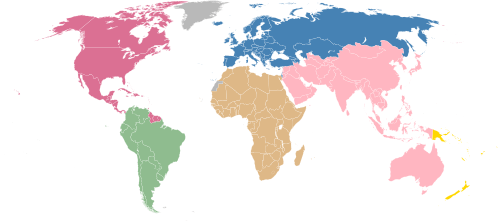São Tomé and Príncipe women's national football team
| Association | Federação Santomense de Futebol |
|---|---|
| Confederation | CAF (Africa) |
| Sub-confederation | UNIFFAC (Central Africa) |
| FIFA code | STP |
| FIFA ranking | |
| Current | n/a |
| Highest | n/a |
| Lowest | n/a |
| First international | |
|
(10 August 2002) | |
| Biggest defeat | |
|
(24 August 2002) (26 February 2006) | |
São Tomé and Príncipe women's national football team is the national team of São Tomé and Príncipe. The team has played in four FIFA recognised matches and has never been internationally ranked by FIFA. The country also has a national under-19 team.
History
In 1985, almost no country in the world had a women's national football team,[1] including São Tomé and Príncipe who did not play their first FIFA recognised fixture until 2002 when they participated in qualifications for the 2003 Women's World Cup.[2][3] In the team's history, they have only played in four FIFA recognised matches.[2] On 10 August 2002 in Sao Tome, São Tomé and Príncipe lost to Gabon 0–2 after being down 0–1 at the half.[2][3] On 24 August 2002 in Libreville, São Tomé and Príncipe lost to Gabon 0–6 after being down 0–3 at the half.[2][3] They finished last in the first group round, scoring 0 total goals and having 8 scored against them in two games.[3] On 19 February 2006 in São Tomé and Príncipe, São Tomé and Príncipe lost 0–3 to Togo.[2] On 26 February 2006 in Togo, São Tomé and Príncipe lost 0–6 to Togo.[2] In 2010, the country did not have a team competing in the African Women's Championships during the preliminary rounds[4] or at the 2011 All Africa Games.[5] In June 2012, the team was not ranked in the world by FIFA.[6] The team has never been ranked by FIFA.[7]
Under-20
In 2002, São Tomé and Príncipe women's national under-19 football team participated in the African Women U-19 Championship, the first edition of the competition to be held. In the first round, they lost to Mali women's national under-19 football team twice with scores of 0–6 and 1–4.[8][9] The age grouping for the youth national cup was subsequently changed from under-19 to under-20.[10] São Tomé and Príncipe women's national under-20 football team was supposed to play against Central African Republic women's national under-20 football team in the African Women U-20 World Cup 2010 Qualifying in 2010 but São Tomé and Príncipe withdrew and Central African Republic got a walkover in their scheduled matches against the country.[11]
Background and development
The island country gained independence in 1975, the same year the national football association was created. The association gained FIFA recognition in 1986.[12][13] Female players register with the national association starting at the age of 16. In 2009, there were only four women's only teams in the country, which formed a national competition.[14]
Early development of the women's game at the time colonial powers brought football to the continent was limited as colonial powers in the region tended to take make concepts of patriarchy and women's participation in sport with them to local cultures that had similar concepts already embedded in them.[15] The lack of later development of the national team on a wider international level symptomatic of all African teams is a result of several factors, including limited access to education, poverty amongst women in the wider society, and fundamental inequality present in the society that occasionally allows for female specific human rights abuses.[16] When quality female football players are developed, they tend to leave for greater opportunities abroad.[17] Continent wide, funding is also an issue, with most development money coming from FIFA, not the national football association.[17] Future success for women's football in Africa is dependent on improved facilities and access by women to these facilities. Attempting to commercialise the game and make it commercially viable is not the solution, as demonstrated by the current existence of many youth and women's football camps held throughout the continent.[15]
References
- ↑ Chrös McDougall (1 January 2012). Soccer. ABDO. p. 45. ISBN 978-1-61783-146-1. Retrieved 13 April 2012.
- 1 2 3 4 5 6 "Sao Tome e Principe: Fixtures and Results". FIFA. Retrieved 16 April 2012.
- 1 2 3 4 "Previous Tournaments". FIFA.com. Retrieved 16 April 2012.
- ↑ "Fixtures – African Women Championship 2010 – CAF". Cafonline.com. Retrieved 13 April 2012.
- ↑ "Groups & standings – All Africa Games women 2011 – CAF". Cafonline.com. Retrieved 13 April 2012.
- ↑ "The FIFA Women's World Ranking". FIFA.com. 25 September 2009. Retrieved 7 June 2012.
- ↑ "Sao Tome e Principe: FIFA/Coca-Cola World Ranking". FIFA.com. Retrieved 16 April 2012.
- ↑ "African Women U-19 Championship 2002". Rsssf.com. Retrieved 13 April 2012.
- ↑ "Regulations – CAN U-20 women 2010 – CAF". Cafonline.com. Retrieved 16 April 2012.
- ↑ "Women U-19/U-20 World Cup". Rsssf.com. 21 January 2011. Retrieved 13 April 2012.
- ↑ "African Women U-20 World Cup 2010 Qualifying". Rsssf.com. Retrieved 13 April 2012.
- ↑ "Goal! Football: São Tomé and Príncipe" (PDF). FIFA. 21 April 2009. p. 1. Retrieved 5 June 2012.
- ↑ FIFA (2006). "Women's Football Today" (PDF): 166. Retrieved 5 June 2012.
- ↑ "Goal! Football: São Tomé and Príncipe" (PDF). FIFA. 21 April 2009. p. 3. Retrieved 5 June 2012.
- 1 2 Peter Alegi (2 March 2010). African Soccerscapes: How a Continent Changed the World's Game. Ohio University Press. ISBN 978-0-89680-278-0. Retrieved 22 April 2012.
- ↑ Jean Williams (15 December 2007). A Beautiful Game: International Perspectives on Women's Football. Berg. p. 186. ISBN 978-1-84520-674-1. Retrieved 13 April 2012.
- 1 2 Gabriel Kuhn (24 February 2011). Soccer Vs. the State: Tackling Football and Radical Politics. PM Press. p. 34. ISBN 978-1-60486-053-5. Retrieved 13 April 2012.
